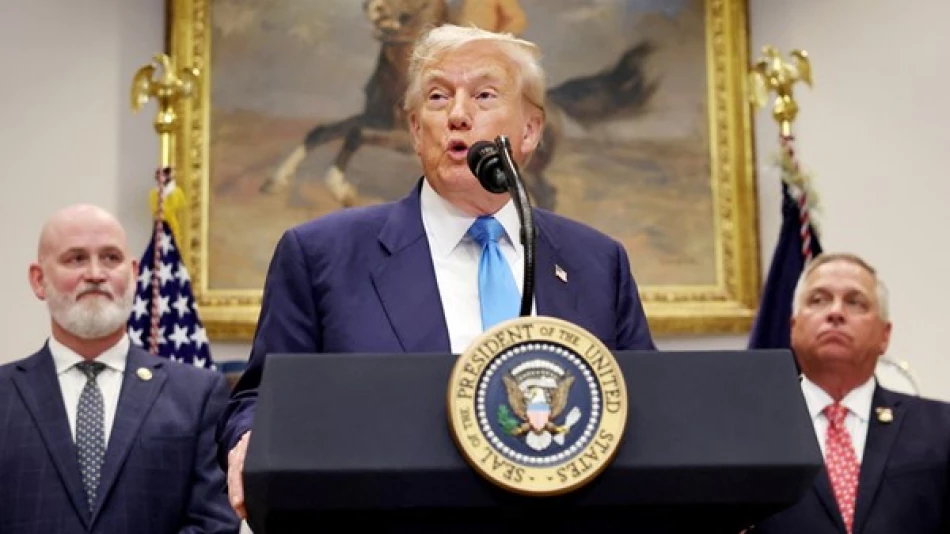
Trump Imposes 50% Tariff on Copper Imports, Shaking Global Metal Markets
Trump Slaps 50% Tariffs on Copper Imports, Citing National Security Concerns
President Donald Trump has signed a declaration imposing sweeping 50% tariffs on copper imports, marking one of the most aggressive trade moves targeting a critical industrial metal. The tariffs, set to take effect August 1st, will apply to semi-finished copper products and copper-intensive derivatives, potentially reshaping global supply chains and driving up costs across multiple industries from construction to electronics.
National Security Justification Expands Trade War Toolkit
The White House framed the copper tariffs as a national security imperative, with Trump citing a "robust national security assessment" likely conducted by the Commerce Department earlier this year. This approach mirrors the administration's use of Section 232 of the Trade Expansion Act of 1962, previously deployed against steel and aluminum imports.
Trump emphasized copper's strategic importance, noting that it ranks as "the second most used material by the Department of Defense." This classification allows the administration to bypass traditional trade dispute mechanisms and implement tariffs unilaterally, avoiding lengthy negotiations or World Trade Organization procedures.
Market Implications and Supply Chain Disruption
The 50% tariff rate represents one of the steepest trade barriers imposed on a major commodity in recent decades. Copper prices, already volatile due to global economic uncertainties, are likely to experience significant upward pressure in the U.S. market.
Industries Facing Cost Pressure
Several sectors will bear the immediate impact of higher copper costs:
Construction and infrastructure projects rely heavily on copper wiring and plumbing systems. The tariffs could inflate costs for residential and commercial developments, potentially slowing the housing recovery.
Electronics manufacturers face particular challenges, as copper is essential for circuit boards, wiring, and heat sinks. Companies may need to either absorb higher costs or pass them to consumers through price increases.
Renewable energy projects, including solar installations and wind farms, require substantial copper for electrical components. The tariffs could paradoxically undermine clean energy initiatives by increasing project costs.
Global Trade Dynamics and Retaliation Risks
The copper tariffs signal a continuation of aggressive trade policies that defined Trump's previous term. Unlike his earlier focus on China, this move affects copper suppliers worldwide, including traditional allies like Chile and Peru, which rank among the world's largest copper producers.
Chile, responsible for approximately 28% of global copper production, faces particular exposure to U.S. market disruption. The South American nation's economy depends heavily on copper exports, and sustained tariffs could prompt diplomatic tensions or retaliatory measures.
Comparison to Previous Metal Tariffs
The copper tariffs follow a familiar playbook from Trump's steel and aluminum tariffs implemented in 2018. Those measures, also justified on national security grounds, led to higher domestic prices and prompted retaliation from trading partners. However, they also encouraged some domestic production increases, though economists debate whether the benefits outweighed the costs to downstream industries.
Strategic Implications for U.S. Manufacturing
The administration likely hopes the tariffs will stimulate domestic copper production and processing capacity. The U.S. currently imports roughly 40% of its copper needs, creating potential supply vulnerabilities during geopolitical crises.
However, rebuilding domestic copper infrastructure requires years of investment and regulatory approvals. Mining companies may hesitate to commit substantial capital based solely on tariff protection that could be reversed by future administrations.
The timing also raises questions about implementation challenges. August 1st provides limited adjustment period for companies with existing contracts and supply arrangements, potentially creating short-term market disruptions even as longer-term supply chains adapt.
For investors, the copper tariffs represent both opportunity and risk. Domestic mining companies may benefit from reduced foreign competition, while manufacturers and construction firms face margin pressure from higher input costs. The net economic impact will largely depend on how quickly domestic production can scale and whether trading partners pursue retaliatory measures that affect other U.S. exports.
Most Viewed News

 Layla Al Mansoori
Layla Al Mansoori






